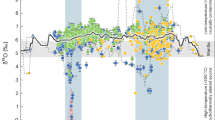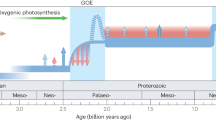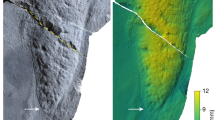Abstract
Carbonate apatite1 with the general formula Ca10 (PO4, CO3)6(F,OH)2 is a major component of the phosphate deposits that occur on numerous coral reef islands2–6. Such insular pohsphates are generally accepted to be the result of chemical interaction between solutions leaching seabird guano and the underlying reef limestone2,7. Details of this process, however, and the specific environmental conditions which promote it, are not yet fully understood8. We present here oxygen and carbon isotope data from carbonate apatites which elucidate the process of phosphogenesis on the Pacific atolls and the palaeoclimatic conditions in which it occurs. We suggest that there were drier climates in the tropics during the Quaternary ice ages associated with an extension of equatorial upwelling in the Pacific.
This is a preview of subscription content, access via your institution
Access options
Subscribe to this journal
Receive 51 print issues and online access
$199.00 per year
only $3.90 per issue
Buy this article
- Purchase on Springer Link
- Instant access to full article PDF
Prices may be subject to local taxes which are calculated during checkout
Similar content being viewed by others
References
McClellan, G. H. J. geol. Soc. Lond. 137, 675–681 (1980).
Hutchinson, G. E. Bull. Am. Mus. nat. Hist. 96, 1–554 (1950).
Burnett, W. C. & Lee, A. I. N. Geo Journal 4.5, 423–436 (1980).
Cook, P. J. in Proc. Phosphorus in Australia Workshop (Centre for Resources and Environmental Studies, Canberra, 1982).
Nugent, L. E. Bull. geol. Soc. Am. 59, 977–994 (1948).
White, W. C., Warin, O. N. Bureau Min. Res. Aust. Bull. 69 (1964).
Owen, L. Q. Jl geol Soc. Lond. 79, 1–15 (1923).
Burnett, W. C. in Fertilizer Mineral Potential in Asia and the Pacific (eds Sheldon, R. P. & Burnett, W. C.) 119–144 (East–West Resource System Institute, Honolulu, 1980).
Kolodny, Y. & Kaplan, I. R. J. sedim. Petrol. 40, 954–959 (1970).
McArthur, J. M., Coleman, M. L. & Bremner, J. M. J. geol. Soc. Lond. 137, 669–673 (1980).
Warin, O. N. in United Nations Min. Res. Dev. Ser. 32, 124–132 (1968).
Veeh, H. H. & Burnett, W. C. Nature 274, 460–462 (1978).
Sullivan, C. H. & Krueger, H. W. Nature 292, 333–335 (1981).
Sofer, Z. Analyt. Chem. 52, 1389–1391 (1980).
Craig, H. Geochim. cosmochim. Acta 12, 133–149 (1957).
Aharon, P. & Chappell, J. in Perspectives on Coral Reefs (ed. Barnes, D. J.) 1–15 (Brian Clouston, Canberra, 1983).
Epstein, S. & Mayeda, T. Geochim. cosmochim. Acta 4, 213–224 (1953).
Craig, H. & Gordon, L. I. in Stable Isotopes in Oceanographic Studies and Paleotemperatures, 9–130 (Consiglio Nazionale Delle Ricerche, Spoleto, 1965).
Hutchinson, G. E. in The Biology of Phosphorus (ed. Wolterink, L. F.) 1–35 (Michigan State College Press, 1952).
Altschuler, Z. S. in Environmental Phosphorus Handbook (eds Griffith, E. J., Beeton, A., Spencer, J. M. & Mitchell, D. T.) 33–96 (Wiley, New York, 1973).
Hudson, J. D. J. geol. Soc. Lond. 133, 637–660 (1977).
Allan, J. R. & Matthews, R. K. Geology 5, 16–20 (1977).
Yurtsever, Y. & Gat, J. R. Stable Isotope Hydrology (Tech. Rep. Ser. no. 210, IAEA, Vienna, 1981).
O'Neil, J. R., Clayton, R. N. & Mayeda, T. K. J. chem. Phys. 51, 5547–5558 (1969).
Shemesh, A., Kolodny, Y. & Luz, B. Earth planet. Sci. Lett. 64, 405–416 (1983).
Mook, W. G. Proc. Conf. on Use of Isotopes in Hydrology, 163–190 (IAEA, Vienna, 1970).
Environmental Isotope Data No 6: World Survey of Isotope Concentration in Precipitation (1972–1975), 1–187 (IAEA, Vienna, 1979).
Aharon, P. EOS 64, 196 (1983).
Joussaume, S., Jouzel, J. & Sadourny, R. Science (submitted).
Flohn, H. in Antarctic Glacial History and World Palaeoenvironments (ed. Van Zinderen Bakker, E. M.) 3–13 (Balkema, Rotterdam, 1978).
Gates, W. L. J. atmos. Sci. 33, 1844–1873 (1976).
Cook, P. J. Proc. CCOP / SOPAC Conf. Apia, Western Samoa (1974).
Friedman, I. & O'Neil, J. R. Geol. Surv. Prof. Pap. 440-KK (1977).
Aharon, P. thesis, Australian National Univ. Canberra (1980).
Gross, M. G. & Tracey, J. I. Science 151, 1082–1084 (1966).
Haggerty, J. A., Weber, J. N., Cuffey, R. J. & Deines, P. Pacif. Geol. 14, 95–112 (1980).
Author information
Authors and Affiliations
Rights and permissions
About this article
Cite this article
Aharon, P., Veeh, H. Isotope studies of insular phosphates explain atoll phosphatization. Nature 309, 614–617 (1984). https://doi.org/10.1038/309614a0
Received:
Accepted:
Issue Date:
DOI: https://doi.org/10.1038/309614a0
This article is cited by
-
Geochemical evidence for the variation of historical seabird population on Dongdao Island of the South China Sea
Journal of Paleolimnology (2006)
-
Mid-oceanic carbonate platforms as oceanic dipsticks: examples from the Pacific
Coral Reefs (1991)
-
Isotopically depleted rainfall and El Niño
Nature (1988)
Comments
By submitting a comment you agree to abide by our Terms and Community Guidelines. If you find something abusive or that does not comply with our terms or guidelines please flag it as inappropriate.



